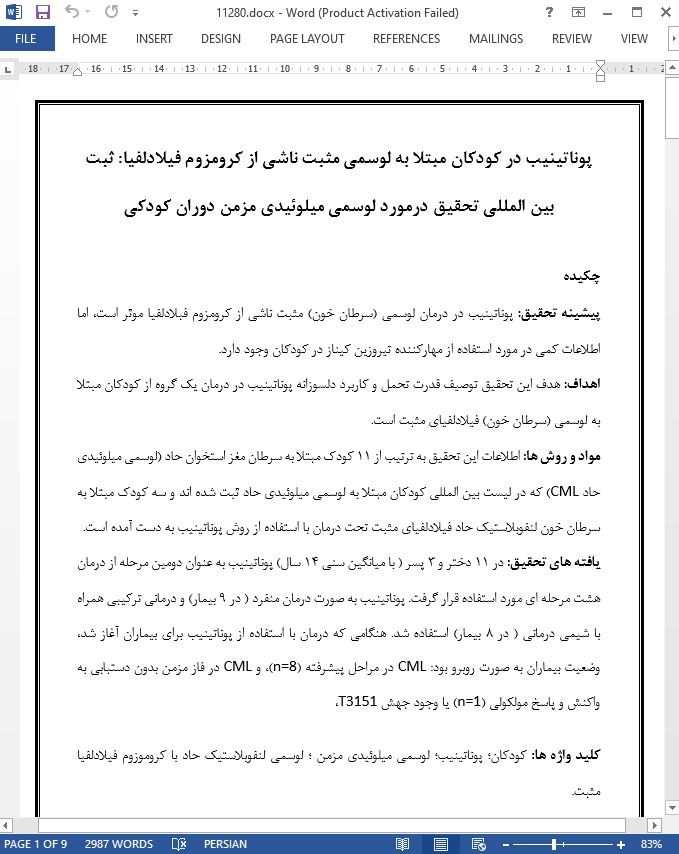
پوناتینیب در کودکان مبتلا به لوسمی مثبت ناشی از کرومزوم فیلادلفیا
چکیده
پیشینه تحقیق: پوناتینیب در درمان لوسمی (سرطان خون) مثبت ناشی از کرومزوم فبلادلفیا موثر است، اما اطلاعات کمی در مورد استفاده از مهارکننده تیروزین کیناز در کودکان وجود دارد.
اهداف: هدف این تحقیق توصیف قدرت تحمل و کاربرد دلسوزانه پوناتینیب در درمان یک گروه از کودکان مبتلا به لوسمی (سرطان خون) فیلادلفیای مثبت است.
مواد و روش ها: اطلاعات این تحقیق به ترتیب از 11 کودک مبتلا به سرطان مغز استخوان حاد (لوسمی میلوئیدی حاد CML) که در لیست بین المللی کودکان مبتلا به لوسمی میلوئیدی حاد ثبت شده اند و سه کودک مبتلا به سرطان خون لنفوبلاستیک حاد فیلادلفیای مثبت تحت درمان با استفاده از روش پوناتینیب به دست آمده است.
یافته های تحقیق: در 11 دختر و 3 پسر ( با میانگین سنی 14 سال) پوناتینیب به عنوان دومین مرحله از درمان هشت مرحله ای مورد استفاده قرار گرفت. پوناتینیب به صورت درمان منفرد ( در 9 بیمار) و درمانی ترکیبی همراه با شیمی درمانی ( در 8 بیمار) استفاده شد. هنگامی که درمان با استفاده از پوناتینیب برای بیماران آغاز شد، وضعیت بیماران به صورت روبرو بود: CML در مراحل پیشرفته (n=8)، و CML در فاز مزمن بدون دستبابی به واکنش و پاسخ مولکولی (n=1) یا وجود جهش T3151،
1. مقدمه
مهارکننده های تیروزین کیناز (TKIs) آنكوپروتئین های BCR-ABL را در فرآیند درمان حالت بدخیم در این بیماری هدف قرار داد، این مورد توانست انقلابی در درمان بیماران مبتلا به لوسمی میلوئید مزمن فیلادلفیا (Ph +) و سرطان خون لنفوبلاستیك حاد Ph + (Ph + ALL) ایجاد کند. ایماتینیب اولین نوع از مهارکننده های تیروزین کیناز یا TKI بود که برای درمان CML و Ph + ALL مورد استفاده قرار گرفت و TKI های نسل دوم مانند داساتینیب و نیلوتینیب در درمان بیمارانی موفق عمل کرد که به نسل اول این مهارکننده مقاومت داشته و یا درمان با استفاده از مهار کننده های نسل اول در انها با شکست مواجه شده بود. به تازگی نیز، نسل سوم TKI تحت عنوان پوناتینیب، برای غلبه بر مقاومت در برابر TKI های نسل اول و دوم در بیماران مبتلا به CML و Ph + ALL تولید شده است.
Abstract
Background Ponatinib is effective in adults with Philadelphia chromosome–positive (Ph+) leukaemias, but scant data are available regarding the use of this tyrosine kinase inhibitor in children. Aims The aim of this study isto describe the tolerance and efficacy of compassionate use of ponatinib in a paediatric cohort of patients with Ph+ leukaemias.
Methods Data from 11 children with chronic myeloid leukaemia (CML) registered to the international registry of childhood chronic myeloid leukaemia and from 3 children with Ph+ acute lymphoblastic leukaemia (Ph+ ALL) treated with ponatinib were collected retrospectively.
Results In 11 girls and 3 boys (median age 14 years), ponatinib was used as a second- to eighth-line treatment. Ponatinib was administered as single therapy (9 patients) or in combination with chemotherapy (8 patients). The status of the disease when ponatinib was started was as follows: CML in advanced phases (n = 8), CML in chronic phase without achievement of molecular response (n = 2) or presence of T315I mutation (n = 1) and Ph + ALL in molecular (n = 1) or marrow (n = 2) relapses. The median dose administered was 21.4 mg/m2 and median duration of ponatinib was 2.5 months. Ponatinib alone or in combination with chemotherapy administered on 16 occasions led to achievement of major molecular response in 50% of cases. Ponatinib was used as a bridge to transplant in 4 cases. Among the 9 patients treated with ponatinib alone, toxicity grade III–IV (2 patients) was exclusively haematologic. No vascular events related to ponatinib were observed.
1. Introduction
Tyrosine kinase inhibitors (TKIs) have revolutionised the treatment of patients with Philadelphia chromosomeepositive (Phþ) chronic myeloid leukaemia (CML) and Phþ acute lymphoblastic leukaemia (Phþ ALL) by targeting the BCR-ABL oncoprotein underlying the malignant process. Imatinib was the first available TKI for the treatment of CML and Phþ ALL, and second-generation TKIs, such as dasatinib and nilotinib, were successfully introduced in patients with failure or intolerance to imatinib. Recently, ponatinib, a third-generation TKI, was developed to overcome resistance to first- and second-generation TKIs in patients with CML and Phþ ALL.
چکیده
1. مقدمه
2. روش ها
3. نتایج
3.1 خصوصیات بیمار
3.2 پاسخ کلی
3.3 پوناتینیب پلی برای پیوند
3.4 استفاده از پوناتینیب در کودکان دارای جهش T3151
3.5 سمیت
3.6 بقا
4. بحث
5. نتیجه گیری
Abstract
1. Introduction
2. Methods
3. Results
3.1. Patient characteristics
3.2. Overall response
3.3. Ponatinib as a bridge to transplant
3.4. Ponatinib in children with T315I mutation
3.5. Toxicity
3.6. Survival
4. Discussion
5. Conclusion
- اصل مقاله انگلیسی با فرمت ورد (word) با قابلیت ویرایش
- ترجمه فارسی مقاله با فرمت ورد (word) با قابلیت ویرایش، بدون آرم سایت ای ترجمه
- ترجمه فارسی مقاله با فرمت pdf، بدون آرم سایت ای ترجمه


